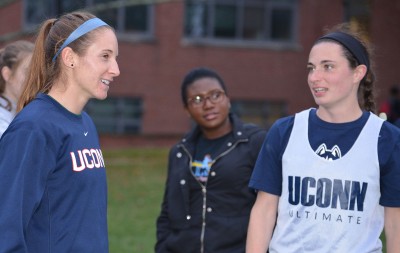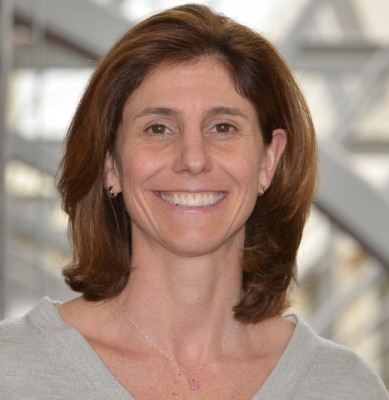Whether it’s the MLB, NFL, or NHL, the world of sports has been cast as a hypermasculine, hypercompetitive environment. While this atmosphere may build toughness and encourage physical fitness, its acceptance toward athletes who identify with the lesbian, gay, bisexual, and transgender community is still in need of practice.
Neag School faculty member Laura Burton is working to change the athletic world’s perception of LGBT athletes – starting with her own students. The sport management associate professor says change must be implemented in every level of sport. LGBT issues in sport is a key topic in her Introduction to Sport Management and Management of Sport Services courses.
From the time children begin playing sports, Burton says, they are often exposed to language that is negatively charged toward LGBT individuals, but unfortunately commonplace in athletics. For example, parents and coaches may find it acceptable to call kids “fags.”
“We need to educate parents and coaches to watch their language to make the environment more supportive and welcoming, so it’s safer for kids to come out,” Burton says.

A supportive environment is what Burton discovered to be the winning recipe in the coming out of LGBT athletes. One of her research studies, titled “Playing it Out: Female Intercollegiate Athletes’ Experiences in Revealing their Sexual Identities,” studied “out” lesbian or bisexual female intercollegiate athletes. The qualitative study, which comprised in-depth interviews with 14 athletes, found it was easier for athletes to come out if other teammates had previously done so. It also discovered that once athletes were out, female teammates were generally accepting – a reaction that took many of the “out” athletes by surprise, but led to greater happiness afterward.
Similar research was conducted at Texas A&M University surrounding workplace culture and LGBT employees in college athletics. In alignment with Burton’s study, a 2015 research paper titled “Creating and Sustaining Workplace Cultures Supportive of LGBT employees in College Athletics” concluded athletic departments with more diverse and welcoming climates were more successful. LGBT employees who could express their true identities and had employees who celebrated those identities had a positive and successful work experience.
‘Lean into the discomfort’
As essential as acceptance is to creating a pro-LGBT environment, Milagros Castillo-Montoya, a Neag School assistant professor of higher education and student affairs, says mere acceptance of LGBT individuals is not enough. In her Leading Toward a Multicultural Educational Environment course, she and her graduate students discuss issues of difference in higher education, including sexual orientation. An early component of the course is analyzing the effect a campus’ culture has on LGBT students.

This means individuals should not only be accepting of LGBT peers, but also able to discuss their identity differences in an honest but noncombative manner. Castillo-Montoya encourages students to first become self-aware and consider their own multiple identities – both the privileged and the marginalized. She uses what is called the LARA Method to teach students the process of effective dialogue: listen, affirm, respond, and ask more questions. With this approach, students can engage in more truthful and meaningful conversations about different identities, such as sexual orientation, race, religion, and ability.
“I ask students to lean in to the discomfort of having conversations across differences,” she says. “They learn to confront the idea, not the person. By doing this in a classroom setting, they build the capacity to talk about and through differences.”
Coming Out in Professional Sports
Transitioning from the classroom to sport, Burton says publicizing one’s LGBT identity can be easier once professional athletes get the ball rolling. When Bryant University men’s basketball coach Chris Burns this fall revealed to USA Today he was gay, the news was welcomed by the public. As he was already well-regarded, Burns’ image did not change.
“People say, ‘Oh, I like him, he’s a good guy; I know him,’” Burton says. “When athletes or coaches at the professional level [come out], it trickles down to the youth level.”
Burton says this trickle-down effect makes the process of coming out seem more attainable and acceptable to college, high school, and youth athletes. She also referenced the U.S. women’s soccer team, which had three players and one coach publicly out at the 2015 World Cup.
“Differences make us stronger as a team.”
– Jenny Gobin ’14 (ED), UConn women’s ultimate Frisbee team coach
Such an inclusive environment has been found in UConn women’s athletics, too. Jenny Gobin ’14 (ED), a graduate of the Neag School’s sport management program who now works for ESPN, has experienced firsthand the power of supportive teammates in making LGBT athletes feel not only accepted, but normal. As an “out” lesbian, Gobin says she was treated just like any other student while at UConn, where she was a student manager of the women’s basketball team and a founder of the ultimate Frisbee club. Today, as the coach for the UConn women’s ultimate Frisbee team – a national contender on the club sports scene – Gobin continues to work closely with lesbian and bisexual athletes.
“We just have to be aware of [differences] and make them seem normal,” she says. “Differences make us stronger as a team.”
However, publicizing one’s sexual identity is at times met with varying reactions based on gender. In an environment where a “macho” mentality is the norm, the process of coming out for male athletes is associated with a legitimate, physical fear of being perceived as incapable or weak. Female athletes don’t face this same fear of ostracization because being lesbian isn’t seen contradictory to being a successful athlete.
LGBT in Sports at UConn
Although Burton says most athletes wait until after college to come out, she’s found UConn to be a safe, supportive environment for those who choose to do so.
“UConn has become a more welcoming place for LGBT athletes and those who are LGBT in the athletic department,” Burton says. “I haven’t heard of negative responses.”
There are resources on campus for LGBT student-athletes, as well as those who aren’t athletes, including athletics support groups, the Rainbow Center, and various cultural centers. UConn’s cultural centers, Castillo-Montoya notes, frequently engage with University faculty regarding all forms of marginalized identities, including the LGBT and student-athlete populations, and are intended to better prepare faculty to lead effective dialogues with their students.
However, Gobin says many athletes prefer to look for support from those they trust most – their teammates and coaches.
“I had an athlete who told me the reason she came out was because of the ultimate [Frisbee] community,” she says. “It’s welcoming, open, and progressive.”
An area that requires more focus, however, is that of bisexual and transgender athletes. Research regarding these identities is less developed than that of gay and lesbian identities. Burton says bisexual individuals experience a sense of invisibility, as they are caught between heterosexual and homosexual identities.
For transgender athletes, questions regarding athletic eligibility are at the forefront of discussion – within the past five years, the NCAA has implemented policies regarding these athletes. Current NCAA policy allows trans male (FTM) athletes to compete for men’s teams, but not women’s teams. Trans female (MTF) must continue to compete on a men’s team.
Gobin recalls an ultimate game in which UConn was playing Smith, an all-women’s college. Smith’s team had one trans male player; because the game was at the club level, the transgender athlete was eligible to play.
“It was interesting and enlightening for my players,” Gobin says. “We had never had that experience before, so it was good to expose that to them.”
Tackling LGBT issues that occur both on and off the playing field has allowed Burton and Castillo-Montoya’s students to become more aware of themselves and of others. Castillo-Montoya’s students write reflections throughout the semester, a “satisfying” indicator of their transforming ability to discuss sensitive subjects regarding diversity.
Meanwhile, Burton reminds her students they must keep in mind that the LGBT community is one of many groups impacting decision-making when it comes to implementing policies in sport and sport management. By representing this community on a level playing field with other groups, more equitable policies will be made.
 Facebook
Facebook
 Twitter
Twitter
 LinkedIn
LinkedIn
